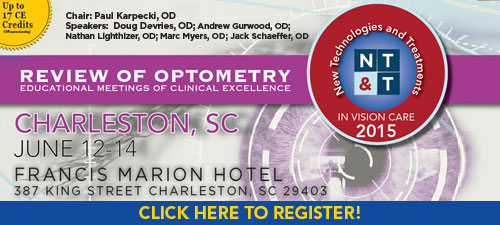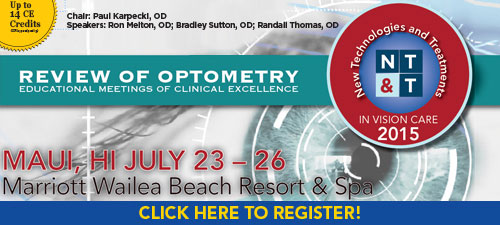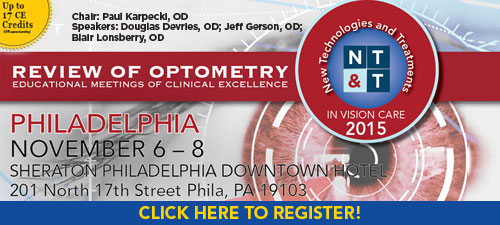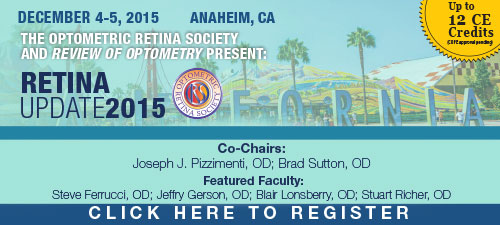
A
weekly e-journal by Art Epstein, OD, FAAO
|
|
Volume 15, Number 20 |
Monday, May 18, 2015 |
Off the Cuff: Gold Standards
Despite a variety of advances in measuring intraocular pressure, almost all agree that Goldmann tonometry remains the
gold standard for measuring IOP. I've performed Goldmann so many times I've long ago lost count, but a recent experience
has shaken my confidence a bit.
|
|||||
|
|
|||||

|
||
| Spectacle-related Eye Injuries, Spectacle-impact Performance and Eye Protection | ||||
|
The aim of this study was to review the prevalence of spectacle-related ocular trauma and the performance of
currently available spectacle materials and to identify the risk factors associated with spectacle-related ocular trauma.
A literature review was conducted using Medline, Embase and Google with the keywords "eyeglasses" or "spectacles" and
"ocular injury"/ "eye injury"/ "eye trauma"/ "ocular trauma." Articles published prior to 1975 were excluded from this
review because of advances in spectacle lens technology and Food and Drug Administration legislative changes requiring
impact resistance of all prescription spectacle lenses in the United States.
Six hundred and ninety-five individual ocular traumas, for which spectacles contributed to or were the main cause of injury, were identified in the literature. Eye injuries occurred when spectacles were worn in sports, in which medium- to high-impact energies were exerted from balls, racquets or bats and/or as a result of a collision with another player. Frame, lens design and product material choice were found to be associated with ocular injury, with polycarbonate lenses cited as the material of choice in the literature. International, national and regional standards for spectacle lenses had a wide range of impact requirements for prescription spectacle lenses, sports eye protection and occupational eye protection. Spectacle-related injury represents a small but preventable cause of ocular injury. With the increasing numbers of spectacle wearers and calls to spend more time outdoors to reduce myopia, spectacle wearers need to be made aware of the potential risks associated with wearing spectacles during medium- to high-risk activities. At particular risk are those prone to falls, the functionally monocular, those who have corneal thinning or have had previous eye surgery or injury. With increased understanding of specific risk factors, performance guidelines can be developed for prescription spectacle eye-protection requirements. |
||||
|
SOURCE: Hoskin AK, Philip S, Dain SJ, Mackey DA. Spectacle-related eye injuries, spectacle-impact performance and eye protection. Clin Exp Optom. 2015;98(3):203-9. |
||||

|
||
| Eye Size and Shape in Newborn Children and Their Relation to Axial Length and Refraction at Three Years | ||||
|
A subset of 173 full-term newborn infants from the Growing Up in Singapore
Towards Healthy Outcomes (GUSTO) birth cohort underwent magnetic resonance imaging (MRI) to measure the dimensions
of the internal eye to determine if eye size and shape at birth are associated with eye size and refractive
error three years later. Eye shape was assessed by an oblateness index, calculated as 1-(axial length/width)
or 1-(axial length/height). Cycloplegic autorefraction (Canon Autorefractor RK-F1) and optical biometry
(IOLMaster) were performed three years later.
Both eyes of 173 children were analyzed. Eyes with longer axial length at birth had smaller increases in axial length at three years. Eyes with larger baseline volumes and surface areas had smaller increases in axial length at three years. Eyes that were more oblate at birth had greater increases in axial length at three years. Using width to calculate oblateness, prolate eyes had smaller increases in axial length at three years compared to oblate eyes, and, using height, prolate and spherical eyes had smaller increases in axial length at three years compared to oblate eyes. There were no associations between eye size and shape at birth and refraction, corneal curvature or myopia at three years. Eyes that are larger and have prolate or spherical shapes at birth exhibit smaller increases in axial length over the first three years of life. Eye size and shape at birth influence subsequent eye growth but not refractive error development. |
||||
|
SOURCE: Lim LS, Chua S, Tan PT, et al. Eye size and shape in newborn children and their relation to axial length and refraction at three years. Ophthalmic Physiol Opt. 2015; May 10 [Epub ahead of print]. |
||||

|
||
| Treatment of Sjögren's Syndrome Dry Eye Using 0.03% Tacrolimus Eye Drop | ||||
|
Forty-eight eyes of 24 patients with dry eye related to Sjögren's syndrome
were enrolled in this study to describe the clinical efficacy of the treatment of Sjögren's syndrome dry
eye using 0.03% tacrolimus eye drop. The patients were randomized in two groups: tacrolimus (n=14) and
vehicle (n=10) group. The tacrolimus group received a vial containing tacrolimus 0.03% (almond oil as
vehicle) and the other group received the almond oil vehicle. All patients were instructed to use the eye drops
every 12h in the lower conjunctival sac. Schirmer I test, breakup time (BUT), corneal fluorescein and rose
bengal staining scores were evaluated in all patients one day before the treatment (baseline), seven, 14, 28 and
90 days after treatment with the eye drops.
The average fluorescein and rose bengal scores improved statistically after seven days of treatment and even more after 90 days. The average Schirmer I and BUT values were unchanged after seven, 14 and 21 days but did show an improvement relative to baseline after 28 days of treatment. Schirmer I, BUT, fluorescein and rose bengal did not show any statistical significance in the vehicle group. Topical 0.03% tacrolimus eye drop improved tear stability and ocular surface status in cases of inflammatory or SS-related dry eye. |
||||
|
SOURCE: Moscovici BK, Holzchuh R, Sakassegawa-Naves FE, et al. Treatment of Sjögren's syndrome dry eye using 0.03% tacrolimus eye drop: Prospective double-blind randomized study. Cont Lens Anterior Eye. 2015; May 5 [Epub ahead of print]. |
||||

|
||
| News & Notes | ||
| FEDERAL APPEALS COURT STOPS UTAH'S ANTI-UPP LAW. A federal appeals court recently stopped a Utah law that would have banned contact lens manufacturers from using Unilateral Pricing Policies to set minimum retail prices on certain products. The law, scheduled to go into effect in Utah on May 12, 2015, was halted on May 14 by the 10th U.S. Circuit Court of Appeals in Denver. At stake is control of the roughly $4 billion contact lens market with some 38 million American customers. Alcon, Bausch + Lomb, and Johnson & Johnson Vision Care asserted that the Utah law is unconstitutional and succeeded in federal appeals court to have it stopped while their appeal is considered. Read more here. | ||
| FDA APPROVES ABBOTT'S IDESIGN SYSTEM FOR LASIK . Abbott Medical Optics has received FDA clearance for the iDesign Advanced Wavescan Studio system for use in LASIK procedures. The wavefront diagnostic aberrometer is able to detect imperfections in the eye that result in poor vision with high-definition scanning technology, according to the company. The scan captures five different optical measurements, enabling the surgeon to provide a more customized LASIK treatment specifically tailored to the patient's eye. In addition, the technology can allow surgeons to better screen patients who were not previously candidates for LASIK, according to the company. Abbott plans to fully launch the iDesign system in the United States in June, 2015. Find out more here. | ||
|
|
||
| NEW DATA SHOWS CLEAR CARE PLUS REDUCES CLINICAL OCULAR ISOLATES. Alcon announced new study results that demonstrated its Clear Care Plus cleaning and disinfecting solution is effective at reducing populations of clinically relevant ocular isolates, including Acanthamoeba. Alcon presented its findings during the annual meeting of the Association for Research in Vision and Ophthalmology (ARVO) earlier this month. Clear Care Plus was evaluated against clinical bacteria and yeast isolates obtained from patients with microbial keratitis or corneal ulcers using the International Organization for Standardization (ISO) 14729 Stand-Alone Test method for disinfection efficacy. After six hours of exposure, Clear Care Plus demonstrated an average of >99.99% reduction of bacterial clinical isolates for each of the six strains tested and >99% reduction of yeast clinical isolates, according to the company. In addition, the new solution demonstrated an average of >99.9% reduction in Acanthamoeba trophozoites and 99% reduction of Acanthamoeba cysts. Results from another Alcon study also presented at ARVO indicated HydraGlyde Moisture Matrix technology, the diblock copolymer wetting technology found in the new solution, had a positive impact on the lubrication properties of silicone hydrogel lenses. Want to know more? Click here. | ||
|
|
||
| PRECLINICAL DATA ON NEW COMPOUNDS FOR GLAUCOMA SHOW PROMISE. Also at ARVO, Nicox announced promising preclinical results from its nitric oxide-donors, NCX 667 and NCX 470, in the treatment of glaucoma and ocular hypertension. Poster "NCX 667, a Novel Nitric Oxide (NO) Donor Lowers Intraocular Pressure (IOP) in Ocular Normotensive and Hypertensive Eyes of Rabbits and Non-human Primates," demonstrated that NCX 667 appeared well tolerated and effective in reducing IOP in two preclinical models of ocular hypertension and glaucoma. In a second poster, NCX 470 appeared well tolerated and more effective than equimolar bimatoprost in reducing IOP in three preclinical models. Additionally, in a preclinical model in which prostaglandin analogs are known to be inactive, NCX 470 lowered IOP, suggesting that its nitric oxide-donating moiety produces an IOP-lowering effect, according to the company. | ||
|
|
||
| PATIENT RECRUITMENT FOR FIRST PHASE III PIVOTAL TRIAL OF FOVISTA IN COMBINATION WITH LUCENTIS IN WET AMD COMPLETE. Ophthotech Corporation announced the completion of patient recruitment for its first Phase III trial of Fovista anti-PDGF therapy in combination with Lucentis (ranibizumab) in wet age-related macular degeneration, according to a company news release. The company expects patient recruitment in the second Phase III trial investigating Fovista in combination with Lucentis to be completed by the end of the third quarter of 2015. A third Phase III trial, which is investigating Fovista in combination with Eylea (aflibercept) or Avastin (bevacizumab), is currently recruiting patients. The company expects the initial, topline data from both Phase III trials of Fovista in combination with Lucentis to be available in 2016. | ||
|
|
Optometric Physician™ (OP) newsletter is owned and published by Dr. Arthur Epstein. It is distributed by the Review Group, a Division of Jobson Medical Information LLC (JMI), 11 Campus Boulevard, Newtown Square, PA 19073.
HOW TO ADVERTISE
|


